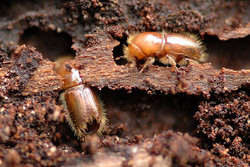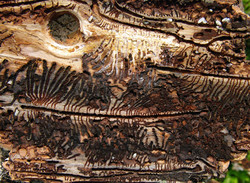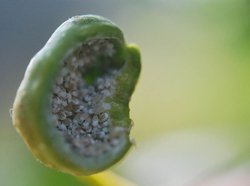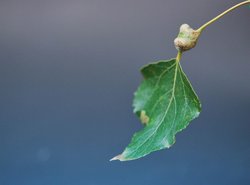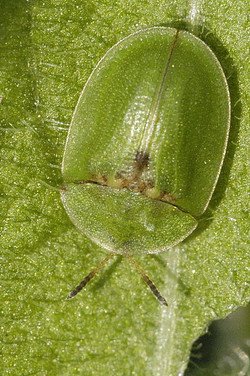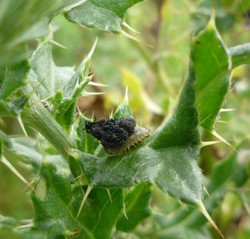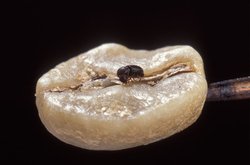Bark Beetles and Ambrosia Beetles
Bark and ambrosia beetles are plant-boring weevils in the Curulionidae (weevil) subfamilies Scolytinae (bark beetles) and Platypodinae (pinhole borers) that have evolved to have a special lifestyle: they spend most of their life in wood, from egg to larva, to pupa and finally adult beetle. Most species prefer to dwell in dead trees. Only a few species are able to overwhelm the defenses of living trees, but some of these species (such as Ips typographus, the European spruce bark beetle) are serious forest pests with a huge ecological and economic impact.
A case of convergent evolution, the beetles in the subfamily Platypodinae have evolved very similar lifestyles and morphologies to those in the subfamily Scolytinae. From a taxonomic point of view, Scolytinae and Platypodinae are two separate weevil subfamilies. Currently, around 6000 Scolytinae and 1400 Platypoidnae species have been described.
Bark Beetles
Morphologically, bark beetles (Scolytinae) are well adapted to their tunneling lifestyle. They are relatively small (mostly between 2 and 5 mm in size), cylindrical and brownish in color. They feed on the inner bark of tree trunks and branches (= phloeophagy). In addition to phloeophagy, some bark beetle species add heartwood to their diets, while others transport fungal spores into the trees they inhabit to enrich the bark they feed on with fungal mycelium (= phloemycetophagy, not be confused with the feeding behavior of the ambrosia beetles, xylomycetophagy, see ‘Ambrosia Beetles’ below). Some American bark beetles in the genus Dendroctonus are proven to be obligately phloeomycetophagous, whereas for the majority of species, fungal associates and their importance for beetle fitness need to be determined.
Bark beetles can be loosely divided into three groups based on their host preferences:
(1) The majority of bark beetles colonize recently dead wood material such as wind felled trees or dead branches.
(2) Only about a dozen bark beetle species worldwide are aggressive, meaning they are able to kill healthy trees by overwhelming the (mostly chemical) defenses of the their hosts. These are the species that cause the most economic damage in forests and are, not surprisingly, the ones best studied. Aggressive bark beetles typically undergo pronounced population dynamics. During an endemic state that can last for several years, the population consists of very few individuals. In this state they only colonize unhealthy trees. If, on the other hand, a storm or drought leads to many stressed or dead trees in a forest, the population of bark beetles may respond and reach an epidemic state, during which large populations of bark beetles are able to kill healthy trees. This state is usually followed by an abrupt population crash of which the underlying mechanisms are not yet understood. The European spruce bark beetle Ips typographus is the only aggressive bark beetle present in Europe.
(3) A very small group of bark beetle species parasitizes living trees, inhabiting live trees in small numbers without killing their hosts. The great spruce bark beetle Dendroctonus micans is the only parasitic bark beetle in Europe.
Because of its widespread ecological and economic impact, the European spruce bark beetle Ips typographus is the main bark beetle species studied in our research group. While it is well-studied and well-known throughout Europe, our research group focuses on finding environmentally acceptable solutions for minimizing the spread and impact of I. typographus in its epidemic state. We are also trying to understand the role of fungal symbionts and their effects on the fitness and population dynamics of I. typographus as well as examining its sensory ecology, in particular its chemical ecology and acoustic communication. We are working with the six-toothed bark beetle Pityogenes chalcographus and several bark beetle species on fir in comparable projects.
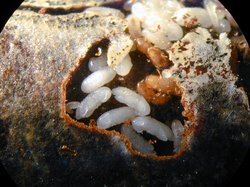
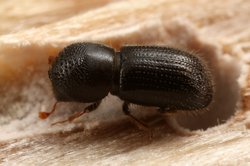
The approximately 3500 weevils within the subfamilies Platypodinae and Scolytinae that feed primarily or exclusively on fungi (= xylomycetophagy or mycetophagy) are known as ‘ambrosia beetles’. This is not a taxonomic, but an ecological designation. While many are part of the bark beetle family and very similar morphologically, ambrosia beetles do not build their tunnels in the inner bark (phloem) of trees. Instead, they live mostly in the nutrient-poor sapwoods and heartwoods of tree trunks and branches. The ambrosia beetles’ solution to this challenge is to cultivate fungi on the interior walls of the tunnels and chambers they dig. The fungus then penetrates into the wood, accumulates nutrients and serves as the beetles’ only or primary food. The fungus, on the other hand, is dependent on the beetles. They transport its spores to new nests in a special spore-carrying organ known as the mycetangium (syn. mycangium). This is an example of obligate interspecific mutualism, a close and essential association between two species (e.g. beetles and fungi) with mutual benefits.
Within their native habitat, ambrosia beetles only colonize dead trees. Some species that have been accidentally transported outside their native range, however, have become invasive and are now also colonizing and in a few cases also killing live trees (e.g. Xyleborinus saxesenii, native to Europe and invasive worldwide).
Establishing and maintaining a healthy fungus garden is very labor intensive. Ambrosia beetles have evolved a high level of intraspecific cooperation to deal with this problem: They live in social groups, dividing the cultivation tasks within the nest between group members. This social lifestyle is unknown among other beetles. In contrast to classical eusocial insects like bees, ants and termites, ambrosia beetle workers are not sterile. The Australian species Austroplatypus incompertus is the known exception: This beetle is assumed to have an obligate social lifestyle similar to that of classical eusocial insects with a reproductive queen and sterile workers, but its behavior has yet to be studied in detail.
While most ambrosia beetle species only display maternal care in the nest, there are a few ambrosia beetle species where the female group members resign from reproducing for several weeks to aid their mother and sisters with fungiculture and caring for the eggs, larvae and pupae in their natal nests. Only later do they disperse and establish their own nests. The native fruit tree pinhole borer Xyleborus saxeseni is the primary example for this cooperative breeding social system. This diversity of social behaviors makes ambrosia beetles interesting models for studying the factors that lead to the evolution of a social lifestyle. Males do not engage in social behaviors: Their only task is to mate with their sisters before dispersal.
One of the main study species in our research group is the cooperatively breeding ambrosia beetle Xyleborinus saxesenii. Even though this species is ubiquitous in Central Europe, it is hardly known outside the scientific community because, like all ambrosia beetles, is spends most of its life hidden in nests in dead wood deep within trees and is very tiny. Females are approx. 2 mm and males 1.5 mm in size. A remarkable finding about X. saxesenii is that even the larvae of this species engage in nest-maintaining tasks. Such a division of labor is not known for any other holometabolous insect (i.e. insects that undergo a complete metamorphosis).
Further reading:
Biedermann & Taborsky (2011), PNAS.
Kirkendall et al (2015). Evolution and diversity of bark and ambrosia beetles. In "Bark Beetles: Biology and Ecology of Native and Invasive Species" (F. E. Vega and R. W. Hofstetter, Eds.), pp. 85-156. Academic Press, San Diego.
The poplar spiral gall aphid (Pemphigus spyrothecae Passerini) is monophagous, which means that it only feeds on a single plant. Its host is black poplar (Populus nigra L.), a Central European tree species.
Poplar spiral gall aphids are social insects and live in family groups. In spring, female aphids hatch from fertilized eggs that have overwintered on the tree. When the first leaves flush, the so-called fundatrices (colony founding mother aphids) induce galls (knot-like hollow structures) in the petioles of leaves. These are then inhabited by the aphids in social groups and are commonly defended. Within the gall, the fundatrix reproduces asexually, or more precicely, parthenogenetically. This means that she has offspring without being fertilized. Aphids are hemimetabolous insects and the larvae resemble adult aphids. Two different morphs of larvae have been observed. In addition to the normal morphs that later become reproductive, there are also soliders, which have thicker legs and a stylet, with which they aggressively defend the nest. This is especially important when the aphids need to form little holes in their gall to allow winged (alate) aphids to leave the nest.
Two factors have likely been relevant for the evolution of sociality in gall aphids. First, due to the parthenogenetic reproduction, all aphids within a colony are highly related - in fact, they are clones, sharing the same genes, which favours cooperation (inclusive fitness theory). Second, a gall is a very precious home. Only during a small time window in spring it is possible for the aphids to induce the galls in the leave petioles, and without common defence, galls are vulnerable to predators.
The geographic range of the poplar spiral gall aphid lies in Europe, North Africa (Tunisia), western Siberia, Pakistan and some locations within Canada.
The hosts of the poplar spiral gall aphid, the back poplar trees, are not only colonized by aphids, but by a range of different insect herbivores. To defend themselves against these antagonists, they use chemical means, for example the emission of volatile organic compounds. Apart from infestations with herbivores, the poplar trees face infections with fungi.
Beetles within the tribe Cassidini are commonly referred to as tortoise beetles. The tribe comprises around 40 genera worldwide and is one of the largest within the subfamily Cassidinae, which itself belongs to the family Chrysomelidae, the leaf beetles. Several of the tropical species of this tribe display parental care, but the European species that we study breed solitarily.
Tortoise beetles owe their name to the flattened shape of the adult beetles. Their wing covers are expanded around the edges, which makes them look a bit like a tortoise. The flattened wings are an adaption to protect the beetles against predators, for example ants, who cannot just simply lift the beetles up and carry them away. In addition, the terminal part of the beetles legs, the tarsi, are equipped with bristles, with which the beetles can strongly adhere themselves to a leave.
Like in all holometabolous insects, beetle larvae look much different from the adult beetles and have no wings. But the larvae of the tortoise beetles have evolved other amazing adaptations to protect themselves from predators who want to eat them, and from parasitoids who want to lay their eggs into them. First, their body is usually equipped with spikes which disrupt their outline and make them less easily visible. Second, they have a pair of little forks at their back with which they can defend themselves. And third, on the end of this fork, they build protective shields from accumulated feces and cast skin. The form, size and structure of these so-called 'faecal shields' are extremely variable between species. The shields seem to help the larvae protect themselves from predators and parasitoids. However, the exact function of the faecal shields is not yet fully understood. For example, in the European thistle tortoise beetle Cassida rubiginosa Müller, the shield is effective against parasitoids and generalist predators, but does not protect the larvae from their main antagonist, the specialist paper wasp Polistes dominulus. It has been assumed that the shields contain repellent substances, for example terpenes, but this has been little investigated.
The species we work with in our lab is Cassida rubiginosa, which is sometimes referred to as the 'green thistle beetle'. It is native to Eurasia, but has been intentionally introduced to the US and New Zealand to control thistles in agricultural areas. The creeping thistle Cirsium arvense (also referred to as the Canada thistle) is its main host plant.
Project involving this organism:
Interactions of thistles, endosymbiotic fungi, and beetle herbivores
The coffee berry borer (Hypothenemus hampei (Ferrari)) is the most devastating insect pest of coffee worldwide. It is originally endemic to Africa, which means that it used to not occur in any other location. However, today it has invaded most coffee producing countries.
Damage ensues after a colonizing female enters the coffee berry and bores tunnel systems (‘galleries’) throughout the two seeds (coffee beans) inside the berry. She then lays her eggs within the tunnels. Upon hatching, larvae feed on the seeds, further reducing the amount and quality of the yield. Brothers and sisters mate within their natal nest inside the berry. Subsequently, when conditions are favorable, the inseminated adult females leave the berry in search of a new coffee berry to colonize.

